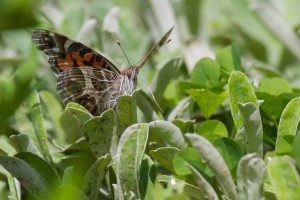By Dawn Weber
Pussytoes is a low-growing native groundcover with understated spring blooms and silvery-green leaves that resemble the soft pads of a cat’s paw. Field or prairie pussytoes, botanically named Antennaria neglecta, are native to the north east and north central US as well as much of Canada. Just a few inches tall, they appreciate full sun to light shade, and dry to average soil.
Without a doubt, there are showier native plants. So why make room in your garden for this unassuming little plant? Because pussytoes is one of the host plants for the American Lady butterfly.
American Lady butterflies need pussytoes. Tiny just-hatched caterpillars cannot travel very far for food, so the female butterfly lays her eggs on a host plant that the new caterpillars can eat.
One Saturday morning, standing in my kitchen, I noticed a butterfly moving around my new sunny garden bed. Grabbing my always-ready camera from the kitchen counter, I went outside to see what kind it was.
After observing for a few minutes and consulting my field guide, I discovered that it was an American Lady butterfly who had found the pussytoes that I planted. For several minutes I watched her select a leaf, lay an egg on the top of the leaf, float away, come back, choose a new leaf and lay another egg.
I only had the opportunity to witness this amazing event because I had planted what she was looking for. Totally worth the bug bites I got sitting in the grass watching her!
Nectar plants are important food for adult butterflies, but host plants for caterpillars are the key to supporting the species. When you choose plants for your garden, be sure to include host plants so that you support the entire life cycle of the butterfly.
Download the Missouri Botanical Garden’s fact sheet for local butterfly species and their host plants.
Dawn Weber is the recipient of the 2013 Landscape Challenge sponsored by Wild Ones, Shaw Nature Reserve, and Grow Native! Wild Ones volunteers installed a native plant garden in her sloped front yard, and it is now home to untold Missouri flora and fauna! That same year, she received a visit and a report from St. Louis Audubon Society’s Bring Conservation Home Habitat Advisors, who asked her join them as a Habitat Advisor. Now, we’re all benefiting from her passion for nature, not to mention her talent in photography. Thank you, Dawn.



Thanks for the information. I did not know this one.